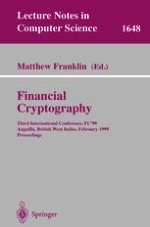1999 | Buch
Financial Cryptography
Third International Conference, FC’99 Anguilla, British West Indies, February 22–25, 1999 Proceedings
herausgegeben von: Matthew Franklin
Verlag: Springer Berlin Heidelberg
Buchreihe : Lecture Notes in Computer Science
Enthalten in: Professional Book Archive
